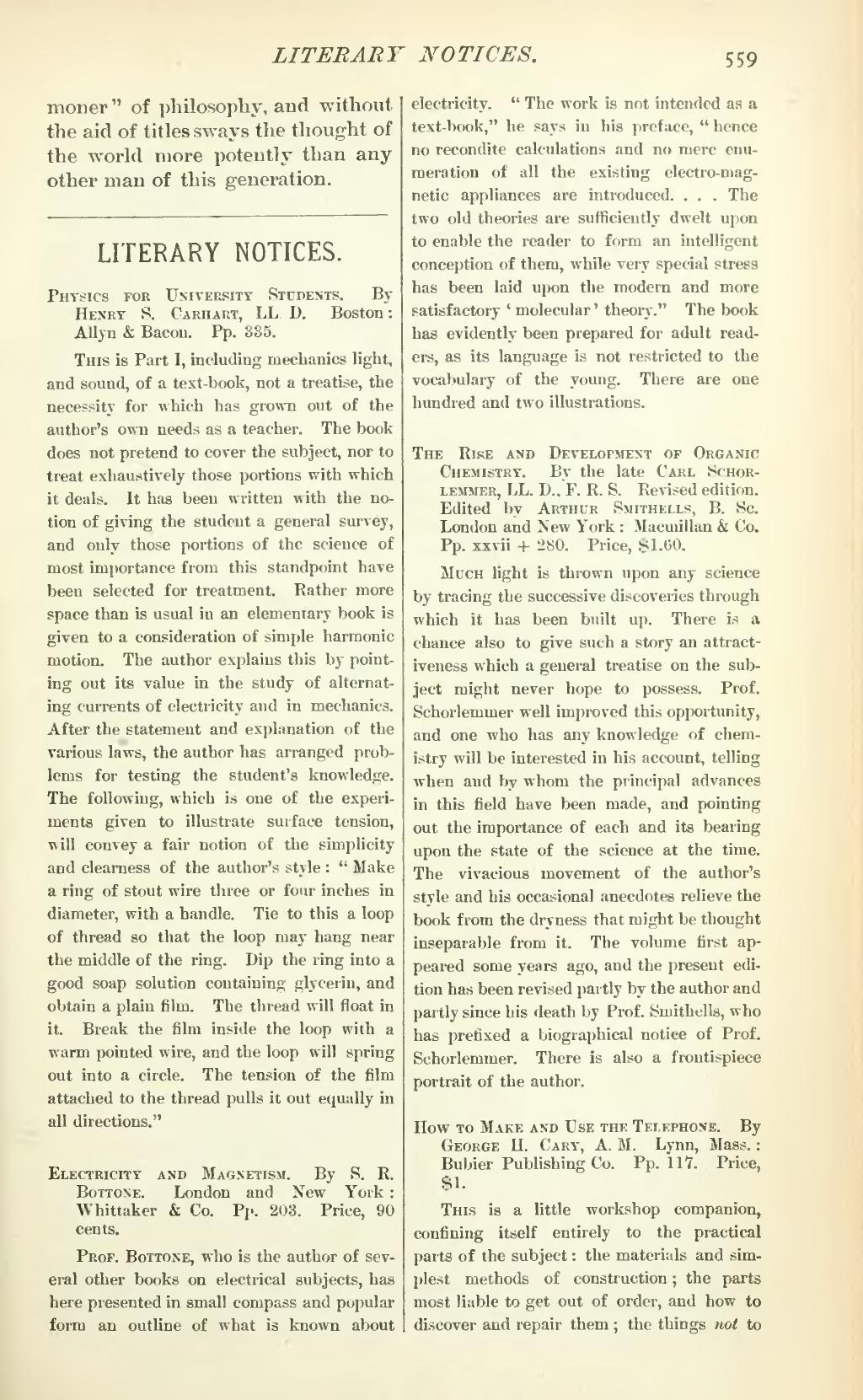moner" of philosophy, and without the aid of titles sways the thought of the world more potently than any other man of this generation.
Physics for University Students. By Henry S. Carhart, LL. D. Boston: Allyn & Bacon. Pp. 335.
This is Part I, including mechanics light, and sound, of a text-book, not a treatise, the necessity for which has grown out of the author's own needs as a teacher. The book does not pretend to cover the subject, nor to treat exhaustively those portions with which it deals. It has been written with the notion of giving the student a general survey, and only those portions of the science of most importance from this standpoint have been selected for treatment. Rather more space than is usual in an elementary book is given to a consideration of simple harmonic motion. The author explains this by pointing out its value in the study of alternating currents of electricity and in mechanics. After the statement and explanation of the various laws, the author has arranged problems for testing the student's knowledge. The following, which is one of the experiments given to illustrate surface tension, will convey a fair notion of the simplicity and clearness of the author's style: "Make a ring of stout wire three or four inches in diameter, with a handle. Tie to this a loop of thread so that the loop may hang near the middle of the ring. Dip the ring into a good soap solution containing glycerin, and obtain a plain film. The thread will float in it. Break the film inside the loop with a warm pointed wire, and the loop will spring out into a circle. The tension of the film attached to the thread pulls it out equally in all directions."
Electricity and Magnetism. By S. R. Bottone. London and New York: Whittaker & Co. Pp. 203. Price, 90 cents.
Prof. Bottone, who is the author of several other books on electrical subjects, has here presented in small compass and popular form an outline of what is known about electricity. "The work is not intended as a text-book," he says in his preface, "hence no recondite calculations and no mere enumeration of all the existing electro-magnetic appliances are introduced. . . . The two old theories are sufficiently dwelt upon to enable the reader to form an intelligent conception of them, while very special stress has been laid upon the modern and more satisfactory 'molecular' theory." The book has evidently been prepared for adult readers, as its language is not restricted to the vocabulary of the young. There are one hundred and two illustrations.
The Rise and Development of Organic Chemistry. By the late Carl Schorlemmer, LL. D., F. R. S. Revised edition. Edited by Arthur Smithells, B. Sc. London and New York: Macmillan & Co. Pp. xxvii + 280. Price, $1.60.
Much light is thrown upon any science by tracing the successive discoveries through which it has been built up. There is a chance also to give such a story an attractiveness which a general treatise on the subject might never hope to possess. Prof. Schorlemmer well improved this opportunity, and one who has any knowledge of chemistry will be interested in his account, telling when and by whom the principal advances in this field have been made, and pointing out the importance of each and its bearing upon the state of the science at the time. The vivacious movement of the author's style and his occasional anecdotes relieve the book from the dryness that might be thought inseparable from it. The volume first appeared some years ago, and the present edition has been revised partly by the author and partly since his death by Prof. Smithells, who has prefixed a biographical notice of Prof. Schorlemmer. There is also a frontispiece portrait of the author.
How to Make and Use the Telephone. By George H. Cary, A. M. Lynn, Mass.: Bubier Publishing Co. Pp. 117. Price, $1.
This is a little workshop companion, confining itself entirely to the practical parts of the subject: the materials and simplest methods of construction; the parts most liable to get out of order, and how to discover and repair them; the things not to
